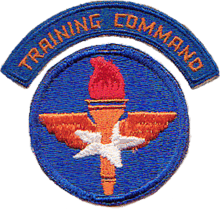Tucumcari Municipal Airport
Tucumcari Municipal Airport (IATA: TCC, ICAO: KTCC, FAA LID: TCC) is about six miles east of Tucumcari, New Mexico.
Tucumcari Municipal Airport | |||||||||||||||
|---|---|---|---|---|---|---|---|---|---|---|---|---|---|---|---|
 1991 USGS Photo | |||||||||||||||
| Summary | |||||||||||||||
| Airport type | Public | ||||||||||||||
| Owner | City of Tucumcari | ||||||||||||||
| Location | Quay County, near Tucumcari, New Mexico | ||||||||||||||
| Elevation AMSL | 4,065 ft / 1,239 m | ||||||||||||||
| Coordinates | 35°10′58″N 103°36′11″W | ||||||||||||||
| Runways | |||||||||||||||
| |||||||||||||||
History
Opened in August 1941, Tucumcari Municipal Airport was built by the United States Army Air Forces, the airfield provided primary glider pilot training.
The glider school was operated under contract by the Cutter-Carr Flying Service, it was under the general supervision of the 9th Glider Training Detachment, 36th Flying Training Wing, Western Flying Training Command.[1] Training was conducted using Aeronca TG-5 combat training gliders, towed by C-47 Skytrain aircraft.[2]
The flight cadets consisted of both experienced sailplane pilots and others who had washed out of conventional pilot training and were given a second chance to fly, The possibility of officer's pay and the chance to fly attracted a particular breed of risk-tolerant trainees. Trainees were given instruction on how to follow a tow plane and fly the unpowered aircraft to the designated landing zone.[3]
Unlike powered pilots, combat training was also provided, as once a pilot committed to a landing and discovered, as he got closer, frequently the landing zone was under fire, mined, or otherwise obstructed, he had little room to maneuver to make a safe landing. Once the landing was made, the glider pilot then became another infantryman.[4]
Once the Glider Pilot Cadet successfully completed their primary training, they moved on to advanced training, taught by AAF instructors at several military glider schools.[3]
The school closed in March, 1943 as part of the drawdown of the Army Air Forces pilot training program. It was declared surplus and turned over to the Army Corps of Engineers, and eventually discharged to the War Assets Administration (WAA) after the end of World War II.
Civil use
Pioneer Airlines served the airport from 1948 until 1953-54, one of several stops on their route between Albuquerque and Dallas. Douglas DC-3s were used at first, replaced by 36-seat Martin 202s in 1953. Trans Central Airlines briefly served Tucumcari in 1970 with Cessna 402s to Albuquerque and Amarillo.
See also
- New Mexico World War II Army Airfields
- 36th Flying Training Wing (World War II)
References
![]()
- 36th Flying Training Wing, lineage and history document Air Force Historical Agency, Maxwell AFB, Alabama
- Military Aviation Incident Reports
- Manning, Thomas A. (2005), History of Air Education and Training Command, 1942–2002. Office of History and Research, Headquarters, AETC, Randolph AFB, Texas ASIN: B000NYX3PC
- Cameron, Rebecca Hancock, 1999, Training to Fly. Military Flight Training 1907-1945, Chapter 4: Training at home for War Overseas. Air Force History and Museums Program, Air Force Historical Research Agency, Maxwell AFB, Alabama
External links
- FAA Terminal Procedures for TCC, effective August 13, 2020
- Resources for this airport:
- FAA airport information for TCC
- AirNav airport information for TCC
- FlightAware airport information and live flight tracker
- SkyVector aeronautical chart for TCC
